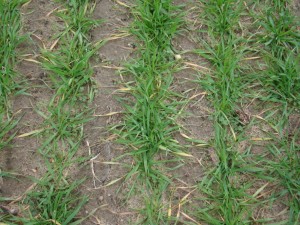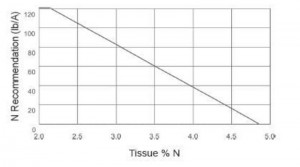I have been getting a few questions about wheat production over the last few days.
The first set of questions concern weed control. Area growers need to determine growth stage of their wheat crop in order to select herbicide options. Below is a figure that shows wheat growth stages and herbicide timing based on wheat growth stages. Currently, (second week of February in the Moultrie area), majority of the wheat crop is reaching growth stage 3 or 4.
Once growers have determined growth stage of development of their crop, we need to identify weed spectrum. I am seeing a lot of wild radish and henbit in area wheat fields. Stanley Culpepper has put out a great resource on wheat weed control for both county agents and growers to use. The weed control information can be seed at this link https://site.extension.uga.edu/colquittag/2015/01/weed-control-options-in-wheat/
Often times I get questions about using 2,4-D and the timing of that product in wheat. Growers might want to consider replacing the 2,4-D with MCPA when trying to control broadleaf weeds.
According to the UGA Wheat Production Guide, MCPA is similar to 2,4-D in that it is a phenoxy herbicide controlling a broad spectrum of broadleaf weeds. When compared to 2,4-D, MCPA is generally less injurious to wheat but also less effective on larger weed species. Application of MCPA is after wheat tillers (preferably 2+ tillers) at a rate of 12 to 16 oz/A (3.7 to 4.0 lb ai material) up to just before jointing; if wheat is fully tillered a rate of 1 to 1.5 pt/A may be applied.
MCPA plus Harmony Extra offers weed control similar to 2,4-D plus Harmony Extra with less crop injury potential.
Nitrogen Management!! Another topic has been nitrogen management. A few wheat growers have split their nitrogen a couple of weeks ago. So what is the next step?
The following information is from the UGA Wheat Production Guide. The graph below is a guide used by growers in North Carolina and Virginia to determine the need for nitrogen at GS 30 (or Feekes 5). It assumes that the average tiller count will be above 100 per square foot. GS 30 is when the leaf sheaths of the wheat plant are strongly erected and splitting the stem shows a hollow internode area about 1/4 to 1/2 inch in length. It is important to have an accurate assessment of the nitrogen content at the right growth stage prior to completing the final N applications. Obtain a representative tissue sample from about 20 areas in the field. Cut the samples about ½ inch above the soil surface making sure to shake any dirt away from the tissue. Pick away any debris or dead leaves from the sample. Combine the samples and mix thoroughly. Take two to three handfuls out of the combined sample for testing and place in a paper bag. Send the sample immediately to an appropriate lab.
Use the graph below to obtain the rate recommendation from tissue test results taken just prior to the onset of stem elongation. Total N applications generally should not exceed 130 lbs N per acre. Make the final N adjustments based on these results.
Call or email if you have any questions about this subject..
Jeremy Kichler




